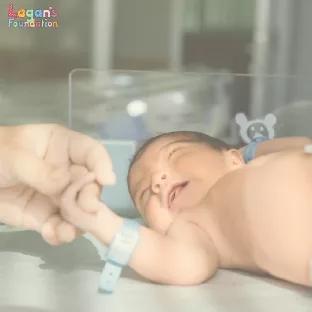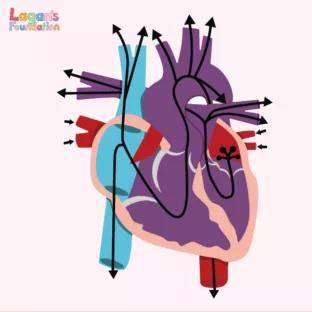
Our Guide to Atrial Septal Defects in Children
Atrial Septal Defects in Children Guide
Atrial Septal Defects are holes in the atrial septum, with their severity dependent on the size and exact location. Fortunately, there are medications and procedures that can treat or manage the disorder.
Our guide aims to help parents and families of children with Atrial Septal Defects to understand the condition better, and how we can help.
What is an Atrial Septal Defect (ASD)?
Simply put, an Atrial Septal Defect (ASD) is a congenital heart condition where a hole in the heart wall (atrial septum) separating the heart’s two upper chambers (atria) does not close after birth. The hole interferes with blood flow from the left atrium to the right atrium, causing a range of health issues.
Symptoms of ASDs include shortness of breath, fatigue, heart palpitations and swelling in the legs or abdomen. However, some ASDs show no symptoms at all.
The condition is diagnosed through physical examination and an echocardiogram, and imaging tests may show ASDs in the left atrium or coronary sinus.
DonateIs an Atrial Septal Defect a serious heart condition?
An Atrial Septal Defect does not always cause worrying symptoms, but doctors consider them a serious heart condition requiring medical attention.
An undiagnosed, untreated or poorly managed atrial septal defect can lead to complications. An abnormal heart rhythm, right-sided heart failure, pulmonary hypertension or stroke can all be caused by ASDs.
The risk of complications depends on different factors, such as the size and location of the defect, as well as the age of the patient at diagnosis. A patient’s overall health status also influences the outcome – some with ASDs might not experience symptoms. Others may experience mild symptoms, resulting from oxygen-poor blood, but this doesn’t mean that the condition is not serious.
Treatment for congenital heart defects, such as Atrial Septal Defects, may involve medication, surgery, or catheter-based procedures. The outlook for people with Atrial Septal Defects is generally good. With early detection and appropriate treatment, the risks of complications are reduced.
Regular follow-up with a healthcare provider is important for monitoring the condition and preventing and managing complications, such as pulmonary hypertension.
What causes Atrial Septal Defects?
The exact cause of Atrial Septal Defects is unknown, but they may occur due to a combination of genetic and environmental factors. Patients with congenital anomalies, such as Down Syndrome or Holt-Oram Syndrome, are at greater risk.
Medications or medical procedures during pregnancy are also thought to increase the risk of Atrial Septal Defects. In very rare cases, ASDs may not be congenital heart disease, but rather from trauma to the chest, or even heart surgery.
Risk factors for developing Atrial Septal Defects include a family history of the condition.
Understanding the potential causes of ASDs can help healthcare providers identify those most at risk. In many cases, as with some other congenital illnesses, the cause of ASDs is unknown.
How common are Atrial Septal Defects?
Atrial Septal Defects are a relatively common type of congenital heart defect. Estimates are that about one in every 1,500 babies is born with an Atrial Septal Defect.
A Secundum Atrial Septal Defect is the most common type of ASD, accounting for about 70% of cases. They form in the middle of the atrial septum. An increase in pulmonary vascular resistance is present in 7-30% of these cases.
20% of these defects are Primum Atrial Septal Defects, and they are often associated with other heart defects. These holes form in the lower portion of the atrial septum. Children with Down syndrome are most at risk. Various other heart defects are associated with primum Atrial Septal Defects in this position, including tricuspid valve and mitral valve defects.
Sinus Venosus Atrial Septal Defects account for the remaining 10% of cases. They are most often associated with vein abnormalities in blood vessels that carry blood back to the heart. The holes occur in the upper and lower back portion of the atrial septum.
Can an Atrial Septal Defect be treated?
The treatment plan for an Atrial Septal Defect depends on its severity. Associated heart issues, as well as the patient’s age and health, will affect the final treatment decision.
In some cases, small Atrial Septal Defects may not require any treatment and may close on their own over time. However, larger Atrial Septal Defects require more urgent treatment. Holes sometimes occur in unusual places; close to pulmonary veins or arteries and are associated with more abnormalities. A catheter is not an option for hole closure in these cases.
Doctors use catheters in cases where small Atrial Septal Defects occur close to the coronary sinus. A large Atrial Septal Defect requires surgery, as the threat of blood clots is high.
After fixing the hole via surgical closure, the body experiences sufficient blood flow. This is due to the left upper heart chamber receiving the requisite amount of blood, instead of losing it through a hole in the septum.
How do you treat an Atrial Septal Defect?
The good news is that there are a variety of ways to treat Atrial Septal Defects, including surgical and non-surgical measures. Surgical treatments can involve the use of a variety of procedures to close the hole. Open heart surgery or minimally invasive procedures, such as cardiac catheterization, may work.
In the case of large Atrial Septal Defects, the recommended treatment usually involves surgery. Small Atrial Septal Defects may benefit from non-surgical treatment options. These may involve the use of devices, such as an occluder, to close the hole.
How long can a person live with an Atrial Septal Defect?
The outlook for children with Atrial Septal Defects is very encouraging, and the majority live full and happy lives.
Life expectancy for a person with any congenital heart disease can vary. Factors such as pulmonary hypertension can play a significant part in a patient’s quality of life, as well as longevity.
The size and location of the defect, as well as the patient’s age at diagnosis, are also defining factors. The presence of any other heart conditions, such as a transient ischemic attack, may negatively affect the overall outcome.
A large Atrial Septal Defect may unfortunately result in further complications affecting the upper chambers of the heart. They may also cause shortness of breath or fatigue. Treating symptoms in time avoids complications that may impact significantly on a child’s quality of life and life span.
The good news is that with timely diagnosis and the appropriate treatment, the outlook for a child with an Atrial Septal Defect is extremely positive.
How can Lagan’s Foundation help?
Lagan’s Foundation offers respite care to families with Complex Health Needs, specialising in Heart Defects and Feeding Issues. The respite consists of highly trained staff attending the family’s home and taking care of the child whilst their parents/guardians take a break.
The carer will take charge of all medications given to the child during their respite hours, as well as any feeding support they may need.
All our staff are specially trained by the charity’s CEO, Training Lead and RCN Clinical Trainer and Assessor, to support children in the North West who have Heart Defects as well as other Complex Health Needs, and during their multiple training days they cover Atrial Heart Defects specifically in depth.


![Understanding Total Anomalous Pulmonary Venous Return [TAPVR]](/wp-content/uploads/2025/04/Understanding-Total-Anomalous-Pulmonary-Venous-Return-FI-312x312-c-default.jpg)


